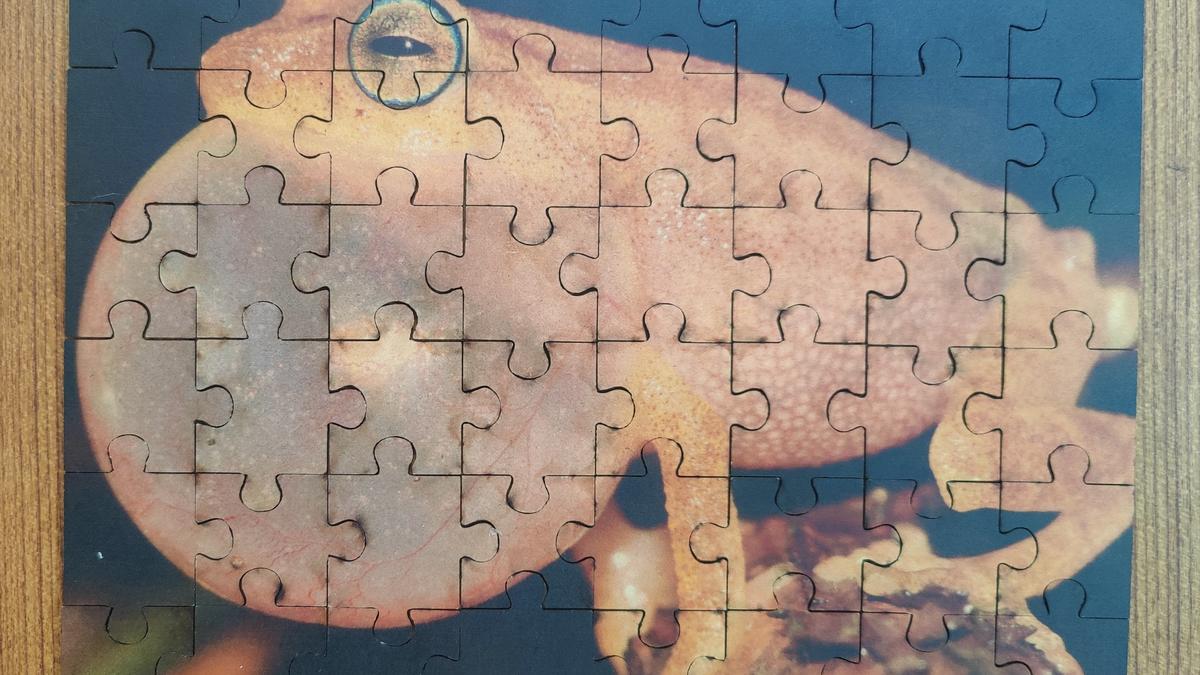
A hop, skip, and jump towards conservation Premium
The Hindu
We are looking at the game map of a unique board game called The Hoppy Frog, developed by Seshadri K.S., Vidisha M.K. and Maria Antony, which allows players to experience how a frog negotiates an anthropocentric world. The game, supported by the IndiaBioscience Outreach Grant, is a way of getting people to think more about amphibians and, hopefully, spread a larger conservation message, says Seshadri, a faculty at ATREE. “Games are a useful pedagogical tool… an important aspect of education,” he says. “We can learn more about frogs by playing a game than by listening to one person speak about them.”
At first glance, the large board game laid out in a corner of the Ashoka Trust For Research In Ecology And The Environment (ATREE) terrace in Jakkur, a north Bengaluru suburb, looks like snakes-and-ladders, with numbered gridded squares that go up from 1 to 100. Look closer, however, and you’ll realise that the players take on the role of frogs, and instead of ladders aiding their progress to the finish and snakes hindering it, there are several red and green cells with curious images on them, such as a termite hill, an ochre car, a pool, a garden, stormclouds, a cityscape and a bird, among others.
We are looking at the game map of a unique board game called The Hoppy Frog, developed by Seshadri K.S., Vidisha M.K. and Maria Antony, which allows players to experience how a frog negotiates an anthropocentric world. The game, supported by the IndiaBioscience Outreach Grant, is a way of getting people to think more about amphibians and, hopefully, spread a larger conservation message, says Seshadri, a faculty at ATREE. “Games are a useful pedagogical tool… an important aspect of education,” he says. “We can learn more about frogs by playing a game than by listening to one person speak about them.”
The impetus for the game came from interacting with children, especially in the natural history workshops focused on frogs conducted in the village of Bisle near Sakleshpur in the foothills of Western Ghats by Bisle Frogwatch, a citizen-led initiative. “It is a two-and-a-half-day camp about appreciating frogs,” says Vidisha, a programme officer at the Dakshin Foundation in Bengaluru.
These workshops, which introduce participants to frogs and teach them skills to identify, document, and study their behaviour, have become more popular over the years. However, it was also felt that engaging participants in more immersive ways could be used since lecture-centred knowledge-sharing in a typical classroom format could get monotonous. So, they thought of having a cool game where people were up on their feet and actively learning about what it is to be a frog in a human-dominated world.
The game, which is now a vital part of the learning experience at Bisle Frogwatch and other workshops, is a great way to sensitise people to the world of frogs and what they could do to protect them since it offers insights into what is good for the frog and what we can do as an individual as well, elaborates Vidisha.
The Hoppy Frog, which was launched in 2024, has had over 800 people playing it so far via workshops conducted in the city and outside of it, including at Science Gallery, Bengaluru, the India Institute of Science’s annual Open Day and the Bisle Frog Walk. There is also an online version of the game developed by the ATREE communications team that is accessible to all on the trust’s website. Since the game has been created under a Creative Commons license, the creators plan to make available the PDF files for the board game and the cards in the public domain. “This way, people can modify content such as language and use it for their own needs,” says Seshadri.
At ATREE, we divide ourselves into two teams, roll two large dice and begin playing the game, the goal of which is to reach the pond where “the frog can live happily ever after,” says Seshadri. Instead of counters, we use origami frogs, which, according to him, is a way for players to understand frog morphology. “At workshops, we make players make their frogs so that they know the different parts of the animal’s body,” he explains.





















 Run 3 Space | Play Space Running Game
Run 3 Space | Play Space Running Game Traffic Jam 3D | Online Racing Game
Traffic Jam 3D | Online Racing Game Duck Hunt | Play Old Classic Game
Duck Hunt | Play Old Classic Game











